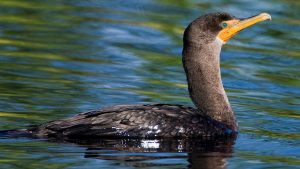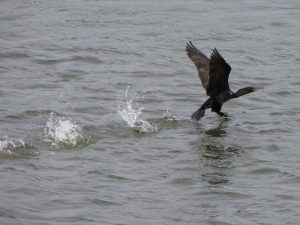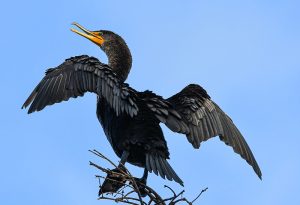
As our charter glides through the pristine waters near Annapolis, where the South River meets the mighty Chesapeake Bay, an unmistakable silhouette catches the eye. Like sleek underwater arrows, double-crested cormorants dive beneath the surface, emerging moments later with silvery fish clasped in their hooked beaks. For visitors who’ve never witnessed these remarkable birds in action, it’s a show that rivals any planned entertainment on the Bay.
Unlike their more celebrated cousins – the ospreys and great blue herons – cormorants bring a unique flair to their fishing expeditions. These glossy, dark-feathered birds are nature’s master anglers, capable of pursuing fish up to 25 feet underwater. Their webbed feet serve as powerful propellers, while their serpentine necks give them the precision of underwater acrobats. What makes them particularly fascinating is their seemingly counterintuitive design – their feathers aren’t as water-repellent as those of other waterbirds, allowing them to dive deeper without fighting against their own buoyancy.

Perhaps one of their most entertaining displays comes when it’s time to take flight. It’s amazing to watch this explosion of energy from the marina dock in Londontowne. Unlike the graceful lift-off of an egret or heron, cormorants put on a show of determined effort, running across the water’s surface with powerful legs and short wings working in concert. Their webbed feet slap against the water as they gain momentum, creating a distinctive pitter-patter across the surface that can stretch for fourty or sixty feet before they finally achieve liftoff. It’s a charming reminder that even nature’s most accomplished swimmers sometimes have to work a little harder to master the air.
After their underwater ballet, these resourceful birds create postcard-worthy scenes as they perch on channel markers, bridge pilings, and weathered deadwood along the shoreline. Wings spread wide like ancient pterodactyls, they cut striking figures against the Maryland sky as they dry their feathers in the Chesapeake breeze. This distinctive posture shares much with their relatives, from the anhinga of Florida’s mangrove swamps to the auks of Arctic waters, each adapted to their own aquatic hunting grounds in similar ways.

So next time you’re cruising the waters around Annapolis, take a moment to appreciate these unsung heroes of the Chesapeake. Their masterful diving, successful hunting strategies, and distinctive silhouettes add another layer of wonder to the Bay’s already rich tapestry of wildlife. In the cormorant’s world, every day is a reminder of nature’s incredible adaptability and the enduring wild spirit that makes the Chesapeake Bay a destination like no other.
